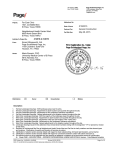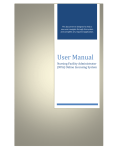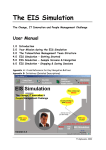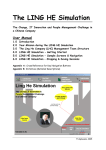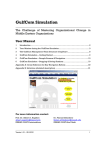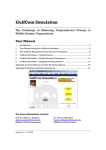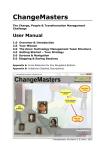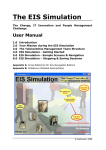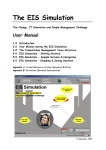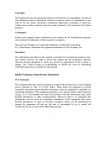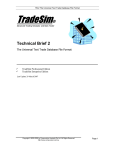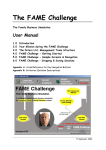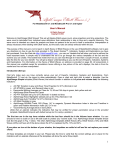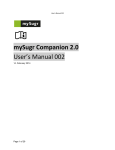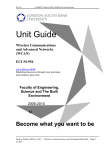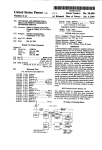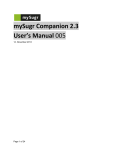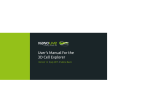Download EduChallenge Manual
Transcript
EduChallenge
The Change, Innovation and People Management
Challenge in a Higher Education Contexts
User Manual
1.0
2.0
3.0
4.0
5.0
Introduction
Your Mission during the EduChallenge Simulation
The Graduate School of Mgmt (GSM) Org. Chart
EduChallenge Simulation - Getting Started
EduChallenge Simulation - Sample Screens & Navigation
6.0
EduChallenge Simulation – Stopping & Saving Sessions
Appendix A: Cross Reference for Key Navigation Buttons
Appendix B: Initiatives (Detailed Descriptions)
EduChallenge – 2005 – p.1
EduChallenge
The Change, Innovation and People Management
Challenge in a Higher Education Contexts
1.0 Introduction
In EduChallenge, you will be challenged to introduce an innovation in a business school,
Humfeld University Graduate School of Business (GSM).
Your mission, as formulated by the University Board, is to spend the next 6 months trying
to ensure that a new Quality Assurance System (AcadQual) will be adopted by the key
members of the business school as part of a major university-wide change program. Until
now, the GSM management and Associate Deans appear to have delayed its
implementation.
As displayed in the enclosed screens of the simulation, you will be able to choose among
many different initiatives to meet your goal. In some cases, you may gather information
on the faculty members and managers at GSM (for example who has lunch with whom,
etc.). In other cases, you may take direct action to try to convince idividuals and thus
influence their willingness to adopt the proposed innovation.
Each time you implement an initiative, you will receive feedback about the impact of your
decision immediately. The objective is to get as many adopters as possible in the given
time.
The following screens illustrate in more detail the purpose and the main elements
EduChallenge, and explain the navigation of the screens, should you have any difficulty.
EduChallenge – 2005 – p.2
2.0 Your Mission during the EduChallenge Simulation
First, review your mission by clicking on the ‘Mission’ button in the upper right oval box of
the screen. You will then access the ‘Mission’ screen which has 4 buttons called ‘The
Context’, ‘The Change Plan’, ‘Your Challenge’ and ‘How to go about it’. The information
you will access is shown in the following four screens.
The Bologna Process is the most important and wide ranging reform of higher education
in Europe for almost 40 years. It provides a clear message and ambitious targets for
European Higher Education Institutions, and its implementation involves a significant
rethinking of current teaching structures, units, methods, evaluation, the permeability
between disciplines and institutions, as well as measures aimed at enhancing academic
quality and the employability of graduates (for more information, see "TRENDS 2003:
Progress towards the European Higher Education Area", S. Reichert und C. Tauch,
European Commission, Directorate General for Education and Culture).
The key idea underlying the Bologna Process, similarly to analogous processes launched
worldwide, is that conventional assumptions about students, the collegiate experience,
learning, teaching, and assessment will not serve higher education well in the 21st
century. Collectively, the trends clearly require educators (i.e., faculty members and
administrators alike) to re-examine -- and probably transform -- current assumptions
about the ways we engage learners in the educational process.
This re-examination must carefully scrutinize beliefs about who our students are, how
they learn, their level of preparation, other demands being made on their time and
attention (e.g., family and work), and their educational and occupational goals. The reexamination must also extend to current beliefs about the roles and responsibilities of
EduChallenge – 2005 – p.3
teachers and learners, the learning/teaching process and how it can best be facilitated,
and how we can create and sustain significant educational communities.
Two years have passed since the President of Humfeld University, one of Europe’s oldest
and most respected Higher Education institutes, proudly announced the university-wide
rollout of a new system called “AcadQual”. Adopting this new Quality Assurance System –
said the President - would help the whole university to implement smoothly and efficiently
a major innovation process, providing all those involved (faculty, administration, and
even students) with a new set of transparent processes and university-wide support
systems to help the move towards a new way of operating, fully aligned with the Bologna
Process and with the ambition of a 21st century educational institution.
Over the last two years, most of Humfeld University’s faculty and administrative
departments have learned to use and appreciate the key features of AcadQual and the
new ways of working it has introduced university-wide.
Where it was already implemented, the project corresponded to the redesign of existing
processes and the introduction of new ones. All these Quality-Assurance oriented
processes were supported by one or more modules of a new intranet-based system, the
AcadQual system, which was introduced gradually to administrative staff, faculty
members, researchers and even students.
Currently, the six most important modules of the AcadQual system include:
1. A Reporting & Analysis module used university-wide to make data collection more
efficient, consistent and transparent. It is through this module that all the data
related to research and teaching inputs and outputs are collected and aggregated.
2. A module supporting EQUIS-compliant Quality Monitoring used by both faculty and
administrative staff to exploit the data collected through the Reporting & Analysis
module to efficiently monitor quality levels.
EduChallenge – 2005 – p.4
3. A Credit Allocation module supporting the systematic planning of courses and the
assignment of faculty members.
4. A Pedagogical Guidelines Knowledge Base module supporting faculty members
across departments to share best practices related to pedagogical issues ranging
from successful handling of class situations to the use of online teaching methods.
5. A Course Bidding and Course Feedback Collection module used by students to
register for courses and provide their assessments about courses and faculty
members.
6. A Group Learning Platform module implemented university-wide to provide a
consistent, web-based platform for the online support of course-related
announcements and information, course material distribution, and faculty-students
online interaction.
It could become the most successful university-wide transformation project of the last few
decades, but actually one big problem is still preventing the President and the Board from
celebrating the successful transition to the new quality assurance system. In spite of the
numerous ‘invitations’ to join the rest of the University in the adoption and
implementation of the new system, no signs of progress have been visible yet at “GSM”,
Humfeld University’s Graduate School of Management.
Until now, the Board has discouraged the President from complaining too loudly about the
fact that GSM has not given any signs of being seriously willing to harmonize its
processes and systems with the new university-wide ones, and has advised him to be
patient. In fact, GSM is rightly considered as the top national business school,
contributing significantly to the excellent image of the University even beyond the
national borders. The achievements of Professor deJong, who has been re-elected twice
as the Dean of GSM are beyond any doubt. Under his very independent-minded
leadership, GSM has succeeded in building very strong links with industry (including
unprecedented high grants and donations), and a solid international reputation (which
makes it the only academic department at Humfeld appearing in the FT Top European
Universities ranking).
EduChallenge – 2005 – p.5
One has to consider that for GSM, adopting the AcadQual system and the process and
structural transformation which comes with it, would effectively represent a significant
change and departure from the systems and processes they have developed, deployed
and used successfully over the last few years.
Two years ago, at the time of the announcement by the President, the Dean of GSM
indicated lots of enthusiasm for integrating the new quality assurance system facilitating
the implementation of the Bologna Process, but since then, objectively, GSM has not
changed its way of operating to any great extent. In particular, all the attempts of the
Board to encourage the introduction of AcadQual at GSM have failed. Sending information
about the advantages of AcadQual and news about its successful adoption in other
schools and departments at Humfeld hasn’t helped a great deal. Professor deJong seems
simply too busy running his successful business school to have time to introduce such a
new system. What have come back are just nicely presented "excuses" of different types
(lack of time and resources, other priorities, etc.).
Now that everybody else has adopted the new quality assurance system, the delaying
tactics of GSM’s Dean are starting to create serious problems, threatening the credibility
and sustainability of the whole project, preventing data from being reported and
consolidated university-wide, and knowledge from flowing smoothly among students and
faculty through the new AcadQual system.
The patience of the President came to an end during the last meeting, as one of his
advisors reported that faculty and administrative personnel at GSM didn’t really know or
care about AcadQual, as Professor deJong had given everybody the impression that this
was mainly a project taking place “somewhere else” in the University, and that it wouldn’t
really affect the way in which GSM operated or force them to review and change the
GSM-specific processes and innovations they were so proud of. The limit had been
reached, and immediate action was needed. With the support of the Board, the decision
was taken to select a number of faculty members and high-level administrative personnel
who had experienced the successful implementation of AcadQual in other schools and
EduChallenge – 2005 – p.6
department at Humfeld University and appoint them to a special team of ‘change agents’
in charge of a delicate mission: Getting GSM on-board. As soon as possible!
In summary, the challenge you and your change agents’ team have to face is to persuade
the Dean of GSM as well as his key collaborators and colleagues to finally adopt the new
Quality Assurance System and harmonize their processes and systems with the ones
adopted by the rest of the University according to the plans of the President and the
Board. You have been given up to 6 months (120 days) for this project. During this time,
you will be able to:
* Gather information about the key stakeholders and players at GSM,
* Implement different change management initiatives,
* Continuously monitor your progress in helping the key stakeholders to move through
the phases of AWARENESS, INTEREST, TRIAL and finally ADOPTION of this innovation.
Your and your team's personal objective is to get as many adopters as possible! This is
the way your performance will be evaluated by the University Board at the end of the 6
months.
Changing the way people think and behave in organizations, and particularly in Higher
Education Institutions, is not a simple task and often requires a combination of different
tactics to be used at the right time with the right people. This simulation will make it
possible for you to experiment with the implementation of different change management
EduChallenge – 2005 – p.7
initiatives, but it will be your task to decide when and with whom to implement a given
tactic.
First of all - before plunging into your first decision - we advise you to:
(1) try to understand the context in which you are going to work. Remember that you
have been sent by the Board! Initially you only have limited information on GSM and its
key stakeholders, and they don’t really know you either !
(2) review the different initiatives you will be able to launch to change people’s attitudes!
(3) develop a "general strategy" which will guide you through the project ("top-down",
"bottom-up", etc.) and write it down!
If necessary you may at any point during the simulation review and adapt your strategy.
Good luck!
To leave the ‘Mission’ screen, click on the ‘Home’ button.
EduChallenge – 2005 – p.8
3.0 The Graduate School of Mgmt (GSM) Org. Chart
The above screen, ‘Org Chart’, shows what is displayed if you click on the ‘Org. Chart’
button at any time during the simulation once you begin.
It is the organisational chart of the top team of GSM in which you are expected to
introduce your innovation during the next 6 months.
The management team of the company consists of 22 individuals, a Students
Representative and the Dean's Personal Assistant. The picture of each person appears
when you position the cursor on the name. If you then click on the box, you will also get
the profile of that person.
You can access this chart at any time during the simulation, and return to where you
were in the simulation by clicking the ‘Home’ button.
EduChallenge – 2005 – p.9
4.0 EduChallenge Simulation – Getting Started
Your second action should be to click on the ‘Strategy’ button in the middle oval box of
the Title Page (see p. 1) and summarize the strategy you are planning to adopt. Include
any revision you may have during the simulation, for instance, after having gathered
more information on the organisation and its managers. Click on ‘Home’ when completed.
To start the simulation, click on “Enter New session” (oval box on the bottom right of the
Title Page. You have to enter your Personal Password to start the simulation.
EduChallenge – 2005 – p.10
5.0 EduChallenge Simulation – Screens & Navigation
5.1 Home Page
On the left hand side of the screen you will see displayed the list of individuals you are
trying to convince to adopt the new Quality Assurance processes and associated AcadQual
system.
A variety of information about every individual can be accessed from this ‘Home’ screen
(depending on the initiatives you take). A status on what you know about a person can be
accessed by placing the cursor over the bubble to the left of the person’s name. A
personal profile can be retrieved by clicking on the (i) bubble to the left of the person’s
name.
The red bars displayed in the box to the right of the individuals' names indicate how
successful you are being in changing the attitude of each person in relation to adopting
the change during the simulation. This is dependent on the initiatives you decide to
implement (you will be able to see an overview of these initiatives on the right hand side
of the screen).
You can see that every individual goes through a cycle of adoption, although at different
paces, and can be ‘not aware’, ‘aware’, ‘interested’, have entered the ‘trial’ phase or have
already ‘adopted’ it.
You can access the ‘Home’ anytime to monitor your progress on the top left hand side of
the screen.
Part of the scoring summary at the end of the simulation is a function of the red bars
representing the degree of positive attitude that you have achieved for each person.
EduChallenge – 2005 – p.11
5.2 Personal Profile
The left hand side of the above screen shows an example of the personal profile, which can
be accessed by clicking on the (i) bubble to the left of the person’s name or clicking on their
name from the ‘Org Chart’ screen. You can also switch quickly between Personal Profiles by
clicking on the arrows on either side of the person’s image. Access to this information is
dependent on the initiatives you have taken.
Click the ‘Home’ button on the top left of the screen to return to the list of all individuals.
5.3 Status
The right hand side of the above screen shows a status on what you know about a
person. This can be accessed by placing the cursor on the left of the person’s name
without clicking.
EduChallenge – 2005 – p.12
5.4 Home - Initiatives
On the right hand side of the screen, you have access to the ‘Initiatives’ corresponding to
the different change management tactics you may launch during the simulation.
A description of a particular initiative will be displayed below this list if you click on any
title. You may also click on ‘Detailed Descriptions’ (in the lower half of the right hand
screen) and scroll through the descriptions of all initiatives at once (see Appendix A).
To implement an initiative from this screen, highlight the initiative and click on
‘Implement It’. This will bring the ‘Take Decision’ screen up (see 5.5) with the initiative
already chosen, and a prompt for any other details you need to provide (ie. the names of
people involved).
EduChallenge – 2005 – p.13
5.5 Take Decision
On the right hand side of the screen, if you click on the ‘Take Decision’ button you will see
the above screen, which shows the number of the decision you are about to take.
To implement an initiative, click on the “Your initiative” box and select the initiative from
the drop down menu that appears. You will also be prompted for any other details you
need to provide (ie. Names of people involved). This can be chosen either by clicking on
the name of the person on the left hand side of the screen, or clicking on the box, and
selecting the person (s) from the drop down menu of names. If you make a mistake in
choosing the initiative or name, or click on the box with the wrong details in it, select
‘Don’t Do It’ instead of “Implement the Decision’ at the bottom of the screen.
For each decision, you can complete the ‘Your rationale for this decision’ box. Finally, click
on ‘Implement the Decision’. You will receive immediate feedback on your chosen
initiative. You will receive a summary of the outcome, a positive or negative indication of
any attitude changes of the people involved (and maybe not involved), and the clock will
continue ticking off along the bottom of the screen (against the 6 months) for the time
taken to implement the initiative.
EduChallenge – 2005 – p.14
5.6 Networks button
Click on ‘Networks’ and you can access information regarding the way people connect –
for instance who has coffee with whom – (‘Short Breaks’), who socialises with whom –
(‘External Links’) and who is on which committee with whom – (‘Committees’). Access to
this information is dependent on the various initiatives you have implemented.
5.7 Notebook
This Version of EduChallenge provides the possibility to take notes anytime during a
session. This Learning Notebook, accessible by selecting
in the upper
right side of the screen also provides a structured way to summarize key insights
and issues after completing a session.
You may fill in the Do’s column on the screen to share “Insights” of what you have
learned from the experience as well as Dont’s column for the “Issues” of Change
Management you would like to know more about. You are able to print it on paper
or on a slide. The content of the Do & Dont’s sheet is recorded in the Session
Report.
EduChallenge – 2005 – p.15
5.8 History
Click on ‘History’ at any point during the simulation and you will see a summary of your
initiatives to date that you can scroll through.
For a detailed history of your Initiatives including Decision #, Initiative, Rationale,
Outcome (ie. the immediate feedback), and No. of Adopters to date – click on ‘History
Details’ and scroll through your results.
EduChallenge – 2005 – p.16
5.9 Score
This shows the score sheet that is displayed if you click the "Score" button at the top of
the screen.
You may click on this at any time to see how you are progressing, and you can return to
the simulation by clicking on the buttons at the top of the screen.
The thin blue line on the graph (the top one) indicates the cumulative ‘positive attitude’
(ie. the red bars) you have succeeded in gathering. As you can see in the example in the
screen above, the cumulative positive attitude can decrease too during the project,
depending on your initiatives and other events that can happen during the 6 months
implementation period!
The thick red line (the bottom line) indicates the cumulative number of individuals you
have convinced to adopt. Once someone has adopted they cannot move back through the
adoption process.
The numeric scores, the number of ‘Days per Adopter’, Elapsed Time, ‘# of Adopters’, and
‘# of Decisions’ ‘# of Attitude Points’ are at the bottom of the screen.
EduChallenge – 2005 – p.17
5.10 EduChallenge Save Session Report
You may save your session’s report at any time during the simulation by clicking on the
“Save Session Report” button on the right hand side of the “Score” screen. The report
allows you to get details about the session including: the date of running, number of
adopters, number of initiatives and the time spent to implement these initiatives and of
course the key points of the adopted strategy and also the content of do and dont’s
learning points. Beside you will also get all the information on the adoption stage of each
person as well as the feedback for each implemented initiative.
5.11 EduChallenge Simulation Credits Screen
This screen provides information about the simulation and those who have contributed to
its design, development and continuous updating. It is displayed if you click on the ‘About’
button located at the top of the screen.
EduChallenge – 2005 – p.18
5.12 EduChallenge Simulation Print
The ‘PRINT’ button allows the printing of any page in the Simulation (e.g the SCORE
page). In case you print directly on a transparency, you will have to insert the
transparency in the printer and choose the appropriate printing options.
6.0 EduChallenge Simulation – Stopping & Saving
Sessions
6.1 Stopping & Restarting
This Version of EduChallenge allows you to “stop” a session anytime you want and
“resume” it at a later stage. To “stop” the session, just quit the simulation software
by closing the simulation screen (Cross Icon
on the top right hand side). The
current session will be automatically saved in a file. To “restart” a session just select
which will appear automatically on the Main
Screen the next time you will enter the simulation software.
6.2
Automatic Saving before Quitting a Session
This Version of the EduChallenge automatically saves a copy of the session every
time you quit the simulation software (in addition to producing the Report in
editable form). Hence the latest state of the session is always stored in a file and
can be reloaded. You can always restart your session from the point you left it by
after restarting.
selecting
EduChallenge – 2005 – p.19
APPENDIX A
Cross Reference for Key Navigation Buttons (at Top of Screen)
Home
Home - Initiatives
Org. Chart
Networks
History
Score
Strategy
Mission
Notebook
About
Refer
Refer
Refer
Refer
Refer
Refer
Refer
Refer
Refer
Refer
5.1
5.4
3.0
5.6
5.8
5.9
4.0
2.0
5.7
5.11
EduChallenge – 2005 – p.20
INITIATIVES
APPENDIX B
DINNER EVENT:
Invite one member of the GSM team to a formal dinner you
organize for the benefit of some University Board Members and other high-level
University officials you have known for many years. (3 days)
NOTE - You are not sure that the person will accept your invitation and that you will
actually be able during the dinner to find the appropriate opportunity to talk in length
about the AcadQual project.
GET PROFILES:
Obtain more information about up to five individuals based on their
personnel records kept in the HR department at GSM. (2 days)
NOTE - Each person’s profile includes a qualitative description of the individual and will
help you understanding how difficult it will be to help that individual move through the
different change phases. The profiles, once gathered, will be available to you during the
whole session.
COMMITTEES:
Identify key processes at GSM for which Committees have been
created recently. This results in an overview of the most relevant Committees and their
members. (5 days)
NOTE - Committee membership will not change, and will remain available throughout the
whole period. This information is accessible by clicking on the button 'Other Networks'.
INTERNAL MAGAZINE: Ask the editor of GSM’s internal magazine to include a
short article you write on the advantages of Quality Assurance Systems in Higher
Education and their link to the Bologna process. To be published in the upcoming edition.
(3 days)
NOTE - This magazine is distributed to all of the school staff. The article is about the
generic advantages of Quality Assurance Systems and the features of AcadQual.
DIRECTIVE: Try to convince the Dean to send out a directive to everybody insisting
that they start using AcadQual in two weeks time. (5 days)
NOTE - You spend several days writing a draft of this directive to give to the Dean.
THE ‘SANDWICH’:
Suggest to a group of selected individuals who already show
strong interest in AcadQual but whose hierarchical superiors (the Institute Heads, the
Deputy Dean or the HR & Administration Director) are still unconvinced, that they should
lobby the Dean to push them to proceed faster with the implementation. (4 days)
NOTE - This initiative assumes that you have identified the appropriate persons to
approach, and does not require you to specify them.
ELECTRONIC MAIL:
Send a brief electronic mail to everyone on the top team
explaining your ideas on why a Quality Assurance Systems like AcadQual makes sense for
them. (1 day)
NOTE - Everybody has an individual e-mail account.
SPECIAL COURSE: Organise for up to five individuals a three-day residential
training programme on the potential benefits of Quality Assurance Systems in Higher
Education and how to actually use such systems. (5 days)
NOTE - You do not attend the course, but it takes a considerable amount of your time to
plan it. In addition, people can only attend such courses only once a year.
SCHOOL MGMT MEETING: Organise a special meeting attended by the Dean, the
Deputy Dean, the Institute Heads and the HR & Administration Director to share and
discuss thoughts, results and action plans for the AcadQual project. (3 days)
NOTE - The Dean, the Deputy Dean, the Institute Heads and the HR & Administration
Director are informed that they can also bring along their collaborators.
EduChallenge – 2005 – p.21
BROWN BAG LUNCH:
Help a selected individual within GSM to organise and lead a
brown bag lunch session including a demonstration and a discussion session on AcadQual
experiences for all those interested in the topic. (5 days)
NOTE - Brown bag lunches are open and advertised to everybody at GSM, even to staff
members, in case they find the topic interesting. This one will provide the opportunity for
the person who will have selected to lead the session to share and gather views and
experiences on AcadQual.
FACE-TO-FACE MEETING:
Fix a meeting with one of the members of GSM’s top
team in order to persuade him/her that the AcadQual project would make sense to
implement. (1 day)
NOTE - The meeting will take place in the person's office.
SHORT BREAKS:
Spend some time in and about the business school in order to see
which groups of individuals meet regularly over short breaks such as lunch, in the
smoking area, or at the coffee machine. (3 days)
NOTE - These groups will not change, and the list will remain available throughout the
whole period. This information is accessible by clicking on the button 'Other Networks'.
MEMORANDUM: Write and send to any five individuals a brief memo on how some of
the specific features of AcadQual will improve the transparency of information flows in
the school. (1 day)
NOTE - This is distributed in the school’s internal mail system.
PILOT TEST:
Try to get commitment from somebody by asking him/her to organise a
two-week-long pilot test of AcadQual in his/her institute or department using current
school data. (4 days)
NOTE - This will involve setting up the AcadQual on the computers of all those involved
and providing users with the appropriate training.
WEEKLY MEETING:
Develop a slide show on AcadQual and the progress of the
project, and present it during the regular weekly meeting that every member of GSM top
team attends. (5 days)
NOTE - The presentation includes potential applications of AcadQual within the different
school processes. All GSM representatives are in principle expected to attend these
meetings.
QUESTIONNAIRE: Write and distribute to everybody a questionnaire aimed at
assessing their current level of interest in becoming regular users of the new AcadQual
system. (2 days)
NOTE - The main objective of using this questionnaire is to demonstrate your approach to
the project and ideally gather additional information.
EXTERNAL SPEAKER:
Invite Professor Sanderman, a well-known academic, to
come and talk about his nation-wide benchmarking study of ‘Performance Improvements
through Quality Assurance Systems in Higher Education’, during which he will go into the
experiences of other schools. (3 days)
NOTE - Everybody at GSM is invited by memo to this event, but attendance is optional. As
a preparation, you enclose in the invitation two research articles on the subject.
EXTERNAL LINKS:
Spend some time observing or finding out which people regularly
play Bridge, go together to the Tennis Club, or are actively involved in local politics
events. (3 days)
NOTE - These groups will not change, and the lists will remain available throughout the
whole period. This information is accessible by clicking on the button 'Other Networks'.
EduChallenge – 2005 – p.22
NEUTRALIZE RESISTERS: Suggest to one of GSM's top managers (the Dean, the
Deputy Dean, the Institute Heads or the HR & Administration Director) that some
outspoken individual resisting and potentially slowing down the AcadQual project should
be "neutralised' (for instance by promoting him/her to a side-ways position) so that
he/she cannot hurt the project. (3 days).
NOTE - You only need to identify the appropriate person to be promoted away. It is
assumed you will be talking to the appropriate authority for such decision. You'll be able
to use this tactic only once!
TASK FORCE: Select up to five members of the GSM team to join you in a Task Force
of change facilitators or "champions", who are to help develop and implement the
proposed changes and eventually influence and train all staff. (5 days)
NOTE - If successful (in case all the selected individuals will join your Task Force) the
team will be active until the end of your intervention period (and hopefully beyond it too).
BULLETIN BOARD:
Ask Donna Winter, the Dean's Assistant, to post a project
progress report on the school’s official Bulletin Board, which hangs on the wall opposite
the main stairwell. You will prepare the project progress report. (2 days)
NOTE - Only Donna Winter has the authority to post messages on the Bulletin Board on
behalf of the Dean. Messages like your project report will remain posted until superseded
by a more recent report.
ONE-LEGGED INTERVIEW: Target one of the members of GSM’s top team and try
to trigger an ‘unplanned’ brief encounter in order to talk informally about the progress of
the AcadQual project. (2 days)
NOTE - You will spend some time in the hallways, in the faculty room, in the parking lot
and in similar spaces in order to maximize the probability of such an encounter with the
person want to target.
SELECTIVE EMAIL: Send an email to up to 5 individuals to provide clarifying
information and make them feel more involved in the project. (1 day)
NOTE - You can also send the email to less than 5 individuals.
EduChallenge – 2005 – p.23
EduChallenge – 2005 – p.24
























